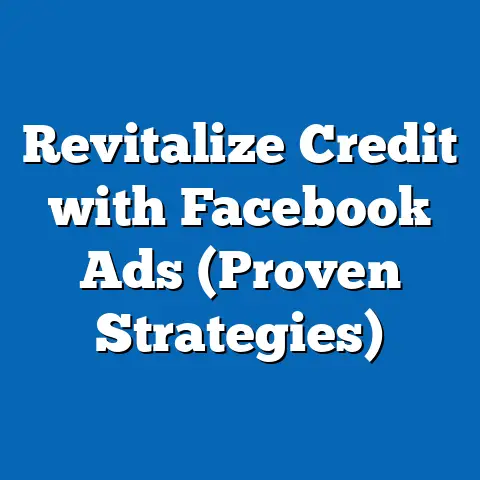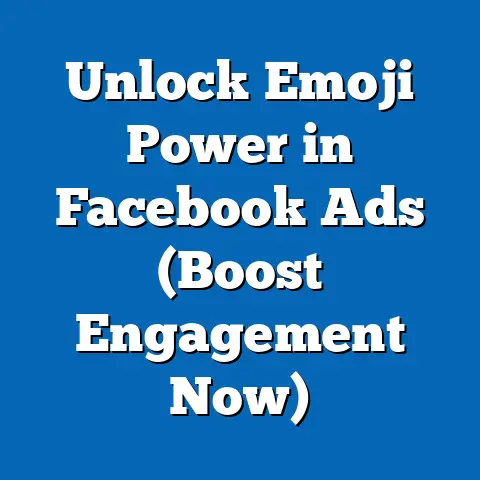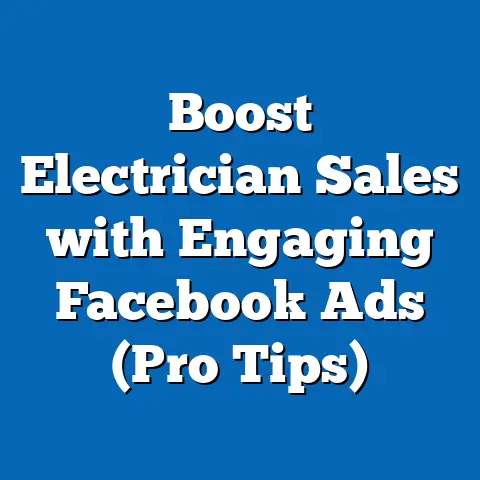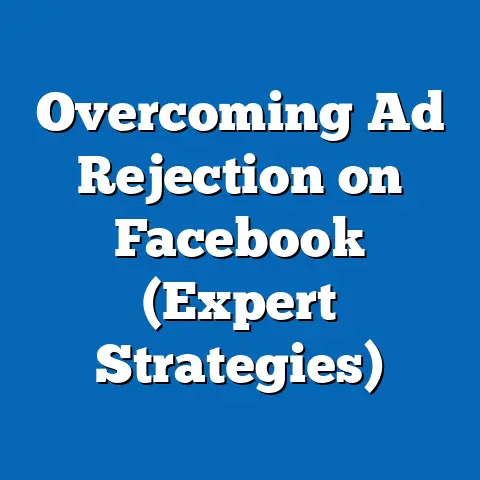Boost Ecommerce Sales with Facebook Ads (Pro Secrets)
Boost Ecommerce Sales with Facebook Ads (Pro Secrets): A Generational Perspective on Digital Marketing Strategies
Introduction: The Wear-and-Tear of Digital Marketing in a Generational Context
In the fast-evolving landscape of digital marketing, the wear-and-tear of strategies like Facebook advertising often mirrors the broader generational shifts that shape consumer behavior. Just as physical objects experience degradation over time due to repeated use, digital marketing tactics can lose effectiveness if not adapted to the changing preferences, values, and technological fluency of different age cohorts. Understanding these generational dynamics is critical for ecommerce businesses aiming to optimize their advertising efforts on platforms like Facebook, which has become a cornerstone of online retail marketing.
Section 1: Generational Definitions and Characteristics
Generational cohorts are typically defined by shared experiences, historical events, and cultural shifts that influence their worldview and behaviors. While these definitions are not rigid and individuals within each group vary widely, they provide a useful framework for understanding broad trends in consumer behavior relevant to ecommerce marketing.
Baby Boomers (Born 1946–1964):
Baby Boomers grew up in a post-World War II era of economic prosperity and social change. They witnessed the rise of television as a dominant medium, shaping their preference for traditional advertising, though many have adapted to digital platforms like Facebook for social connection and shopping. Boomers value trust, quality, and personal engagement in marketing, often responding well to ads that emphasize reliability and nostalgia.
Generation X (Born 1965–1980):
Often referred to as the “latchkey generation,” Gen Xers experienced a shift toward dual-income households and greater independence during their formative years. They bridge the gap between analog and digital worlds, adopting technology as adults while retaining skepticism toward overt marketing. For ecommerce, Gen X responds to straightforward, value-driven messaging on platforms like Facebook, where they often seek practical solutions.
Millennials (Born 1981–1996):
Millennials came of age during the internet boom and the 2008 financial crisis, shaping their digital nativity and economic pragmatism. As the first generation to fully embrace social media, they are highly active on Facebook, though their trust in brands often hinges on authenticity and social responsibility. Ecommerce ads targeting Millennials must prioritize storytelling and peer-driven recommendations.
Generation Z (Born 1997–2012):
Gen Z, the true digital natives, grew up with smartphones and social media as constants. They value individuality, inclusivity, and immediacy, often engaging with brands through short-form, visually rich content. On Facebook, Gen Z users are less dominant compared to platforms like Instagram or TikTok, but they still respond to highly personalized and interactive ad formats.
Recognizing the diversity within these generations is crucial—cultural, socioeconomic, and geographic factors further shape individual preferences. However, these broad characteristics provide a starting point for segmenting audiences in Facebook ad campaigns.
Section 2: Historical Context and the Evolution of Facebook Advertising
Facebook, launched in 2004, has transformed from a college networking site into a global advertising powerhouse, with over 2.9 billion monthly active users as of 2023 (Statista, 2023). Its evolution reflects broader technological and societal shifts that align with generational timelines, influencing how each cohort interacts with the platform.
For Baby Boomers, Facebook emerged as a tool for reconnecting with old friends and family, becoming a trusted space for social interaction in the late 2000s. Their gradual adoption of ecommerce through the platform often stems from seeing ads as extensions of personal recommendations. Meanwhile, Gen Xers embraced Facebook during its early commercial expansion, using it for both personal and professional networking, though they remain wary of privacy concerns—a legacy of their formative years witnessing rapid tech changes.
Millennials, who grew up alongside Facebook, have seen it evolve from a social hub to a marketplace, with features like Facebook Shops launched in 2020 catering directly to their online shopping habits. Gen Z, however, often views Facebook as a “boomer platform,” preferring newer apps, though targeted ads can still capture their attention if aligned with their values and aesthetics. The platform’s advertising tools, such as lookalike audiences and dynamic ads, have become increasingly sophisticated, yet the wear-and-tear of overused tactics—like generic promotions—has led to ad fatigue across all generations.
Historically, significant events like the 2008 recession (impacting Millennials’ frugality), the rise of mobile internet (shaping Gen Z’s expectations for instant access), and global pandemics (accelerating Boomers’ digital adoption) have further influenced how each generation engages with ecommerce via social media. Understanding these contexts is key to crafting ads that resonate rather than wear out their welcome.
Section 3: Societal Implications of Generational Shifts in Ecommerce
The intersection of generational behavior and digital marketing has profound societal implications, particularly in how trust, consumption, and technology shape economic patterns. Baby Boomers, with their significant purchasing power—controlling over 50% of U.S. household wealth (Federal Reserve, 2022)—represent a lucrative yet often overlooked segment for ecommerce. Ads that fail to address their preference for security and clarity can erode trust, reflecting a broader societal challenge of digital inclusion for older generations.
Gen X, often juggling career and family responsibilities, drives demand for convenience in ecommerce, influencing trends like subscription models and one-click purchasing. Their skepticism toward marketing, however, means that over-saturation of ads on platforms like Facebook can contribute to societal cynicism about corporate motives. Millennials, meanwhile, have spearheaded the rise of ethical consumerism, with 73% willing to pay more for sustainable products (Nielsen, 2021), pushing brands to align ads with social causes—a shift that reverberates across industries.
Gen Z’s influence is evident in the demand for transparency and diversity in marketing, with 60% more likely to engage with brands that take a stand on social issues (Morning Consult, 2022). Their shorter attention spans also reflect a societal move toward instant gratification, challenging ecommerce businesses to innovate rapidly. Across all generations, the wear-and-tear of repetitive or irrelevant Facebook ads risks contributing to digital disengagement, a trend with implications for how communities connect and consume in an increasingly online world.
Section 4: Pro Secrets for Boosting Ecommerce Sales with Facebook Ads Across Generations
To combat the wear-and-tear of outdated strategies and maximize ecommerce sales, businesses must adopt targeted, generation-specific approaches while leveraging Facebook’s robust advertising tools. Below are actionable “pro secrets” grounded in generational insights and industry best practices.
4.1 Tailor Content to Generational Values
- Baby Boomers: Focus on trust-building elements like customer testimonials, clear return policies, and detailed product descriptions. Use nostalgic imagery or references to evoke emotional connections, and prioritize desktop-friendly ad formats, as many Boomers still prefer larger screens over mobile.
- Generation X: Highlight value and efficiency with ads that showcase time-saving or cost-effective solutions. Avoid overly flashy designs; instead, use straightforward messaging and calls-to-action (CTAs) like “Shop Now for Deals.”
- Millennials: Emphasize authenticity by integrating user-generated content (UGC) and influencer partnerships into ads. Showcase brand values, such as sustainability, and use storytelling to build emotional resonance.
- Generation Z: Prioritize visually striking, short-form content with bold colors and quick messaging. Incorporate diversity and inclusivity in imagery, and use interactive formats like polls or quizzes to boost engagement.
4.2 Leverage Advanced Targeting and Personalization
Facebook’s ad platform offers powerful tools like Custom Audiences and Lookalike Audiences to segment users based on demographics, interests, and behaviors. For Boomers, target based on life events (e.g., retirement or grandchildren) with ads for relevant products. For Gen X, focus on interest-based targeting tied to hobbies or professional needs.
Millennials respond well to retargeting campaigns that remind them of abandoned carts, especially when paired with limited-time offers. Gen Z benefits from hyper-personalized ads using dynamic creative optimization (DCO), which tailors visuals and copy in real-time based on user data. A 2022 study by eMarketer found that personalized ads can increase click-through rates (CTR) by up to 30% across all age groups, underscoring the importance of relevance over generic content.
4.3 Optimize for Platform Trends and Generational Tech Habits
While Facebook remains a cross-generational platform, usage patterns differ. Boomers and Gen X are more likely to engage with ads in their News Feed, so prioritize static images or carousels with clear messaging. Millennials often interact via mobile devices, making vertical video ads (e.g., Stories) effective, with 62% of users watching Stories daily (Hootsuite, 2023).
Gen Z, though less active on Facebook, can be reached through integrations with Instagram (owned by Meta) or through short, snackable content in Marketplace. Testing ad placements and formats is critical, as overused tactics (e.g., repetitive banner ads) contribute to wear-and-tear, reducing effectiveness over time.
4.4 Address Ad Fatigue with Creative Refresh and A/B Testing
Ad fatigue—when audiences grow tired of seeing the same content—impacts all generations but manifests differently. Boomers may disengage from overly frequent ads, while Gen Z might ignore anything that feels inauthentic. Regularly refreshing creative assets (every 2–3 weeks) and using A/B testing to compare headlines, images, and CTAs can mitigate this.
For example, testing emotional versus rational messaging for Millennials can reveal preferences for storytelling over discounts. A 2021 study by Kantar found that campaigns with frequent creative updates saw a 15% higher engagement rate, proving that innovation counters wear-and-tear.
4.5 Integrate Social Proof and Community Building
Across generations, social proof—such as reviews, ratings, and community engagement—drives trust in ecommerce. For Boomers and Gen X, display verified customer feedback prominently in ads. Millennials value peer recommendations, so encourage sharing through referral programs or “tag a friend” campaigns.
Gen Z thrives on community-driven content, so consider creating or promoting Facebook Groups tied to your brand where users can discuss products. This not only boosts engagement but also counters the societal trend of disconnection by fostering digital communities.
Section 5: Economic, Social, and Cultural Factors Influencing Ad Effectiveness
Beyond generational traits, broader factors shape how Facebook ads perform in ecommerce. Economically, inflation and cost-of-living concerns (notably post-2020) affect Boomers’ and Gen X’s willingness to spend, necessitating ads that highlight value or financing options. Millennials, burdened by student debt and housing challenges, often prioritize experiences over material goods, so ads for unique or experiential products (e.g., travel gear) may outperform generic items.
Socially, the rise of privacy concerns—exacerbated by events like the 2018 Cambridge Analytica scandal—has made all generations more cautious about data usage. Transparent messaging about data policies in ads can rebuild trust, particularly for Gen X and Millennials. Culturally, the push for diversity and inclusion (driven by Gen Z and Millennials) means that ads must reflect varied demographics to avoid alienating audiences.
Technologically, the shift to mobile-first browsing (over 60% of Facebook users access via mobile, per Statista, 2023) requires responsive design, while the growing use of ad blockers (especially among Gen Z) signals wear-and-tear on intrusive formats. Adapting to these trends ensures campaigns remain relevant across generational and cultural divides.
Section 6: Workplace and Industry Implications
The generational dynamics of Facebook advertising extend beyond consumer behavior to influence workplace strategies and industry standards. Ecommerce businesses must train marketing teams to understand generational nuances, hiring diverse talent who can authentically connect with different cohorts. For instance, younger marketers may better grasp Gen Z’s visual language, while seasoned professionals can craft trust-building campaigns for Boomers.
Industry-wide, the wear-and-tear of outdated ad strategies has spurred innovation, with Meta investing in AI-driven tools like Advantage+ to automate targeting and creative optimization. However, over-reliance on automation risks alienating audiences who value human touch, a balance that businesses must navigate. Additionally, the push for ethical marketing (driven by Millennials and Gen Z) is reshaping industry norms, with brands increasingly held accountable for misleading ads—a trend with long-term implications for trust in ecommerce.
Section 7: Forward-Looking Insights and Uncertainties
As generational cohorts evolve and new ones emerge (e.g., Generation Alpha, born 2013 onward), the landscape of Facebook advertising for ecommerce will continue to shift. The platform’s aging user base—skewing toward Boomers and Gen X—may necessitate greater focus on accessibility and trust, while competition from TikTok and other apps could draw Gen Z further away unless Meta innovates with immersive formats like augmented reality (AR) ads.
Economic uncertainties, such as potential recessions, could further impact generational spending, requiring agile ad strategies that prioritize value. Privacy regulations, like the EU’s GDPR and California’s CCPA, will also shape data-driven targeting, potentially increasing the wear-and-tear on current personalization tactics. Businesses must stay proactive, investing in first-party data (e.g., email lists) and community engagement to maintain relevance.
Moreover, the societal move toward sustainability and digital wellness may push brands to reduce ad frequency and focus on quality over quantity—a shift that could redefine ROI metrics. While the future remains uncertain, one thing is clear: understanding generational diversity and adapting to cultural currents will remain central to combating ad fatigue and boosting ecommerce sales.
Conclusion
As technological, economic, and cultural forces continue to shape digital landscapes, the ability to balance innovation with authenticity will be paramount. While uncertainties loom, from privacy shifts to platform competition, a commitment to data-driven, generationally aware strategies ensures that ecommerce brands can thrive on Facebook. Ultimately, success lies in moving beyond one-size-fits-all approaches to embrace the rich diversity of human experience across age cohorts.






